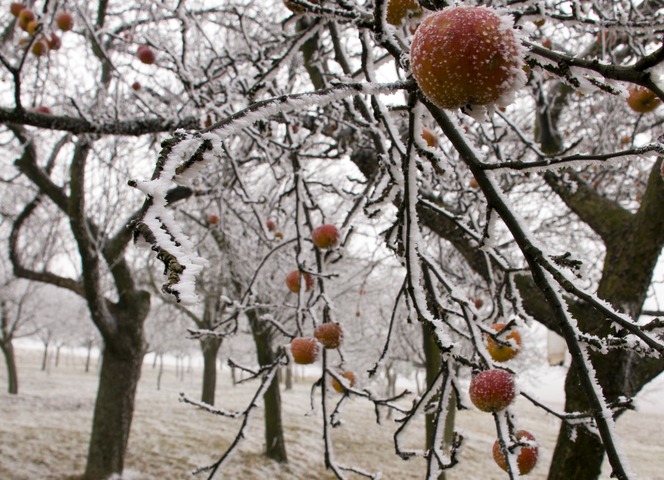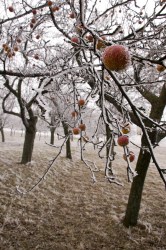Think of your favorite fruits and you might think of the warm climates they tend to thrive in. Florida oranges, Texas grapefruit, California strawberries — and grapes, figs, pears, and apricots. But here’s the funny thing: Most fruit trees have to chill. Literally. Unless they’re tropical, trees have what are called “chilling requirements”: They need winter temperatures to drop to within a certain range — usually just above freezing — and remain there for a set period of time.
This allows the buds to go into dormancy and tolerate harsh winter weather, and to reset themselves for the fruit production cycle to start again when spring comes around.
But what happens when they don’t go dormant because it doesn’t get cold enough outside? As you may or may not have noticed, perhaps depending on your age — winters are getting warmer. If trees don’t get sufficient chilling, they don’t fruit. And as some researchers see it, the future of the planet’s fruit and nut production is in peril. In fact, lack of chill time has already spelled trouble for U.S. farmers growing tree crops, including pistachios, walnuts, and cherries.
Insufficient cold makes for confused trees, says Eike Luedeling, a climate change scientist who has published studies on chilling requirements and fruit trees.
“You have the buds breaking irregularly and over a long time, so it’s kind of staggered — much longer than it should be — and ultimately, it results in having a bad fruit set,” he says.
Which crops will be affected, as weather patterns continue to change? For starters, Luedeling listed: apples, pears, cherries, walnuts and other tree nuts, pomegranates, and olives. But where exactly the list ends is hard to predict.
It’s also hard to say precisely how irregular winters disrupt a tree’s blooming cycle, explains Greg Lang, a horticulture professor at Michigan State University. “There are various stages: The flowers cannot open, or the flowers can open but the pollen doesn’t germinate well, or the pollen can germinate well but the ovules don’t get fertilized strongly,” he says. But the end result is the same: “All of those are going to lead to no fruit.”
Chilling is not a matter of simply accumulating enough hours under a certain temperature; the sequence is crucial. Even if a tree has lived through most of the cold hours it requires in a given year, an unexpected warm day in the middle of February could disrupt the cycle.
“That’s where climate change comes into play … temperatures are fluctuating to a much greater degree. We have warmer days [at] unusual times,” says Lang. And that, he adds, could lead to “some negating of the chilling effect.”
Scientists around the world are researching the connection between climate change and agriculture, with a strong focus on adaptation strategies for big commodity crops like corn and wheat. But there’s little comparable research being done to adapt fruit production to changing climate patterns and conditions. And this has Luedeling concerned. Corn and wheat are “very well-researched,” he says, “but for trees, we’re barely beginning to understand how they work, and they’re much more complicated organisms.”
The answer, in part, might be breeding trees that can grow under changing climatic conditions — something that’s not being done on a wide scale at this point.
“If we make the right decisions, then we won’t have a problem at all,” Luedeling says. “The challenge is looking ahead far enough to put the right trees in place now that can produce under climate conditions 20 years in the future,” he says.
It’s important to keep in mind that trees take years to produce, and live for much longer than many food crops.
“If you grow a cereal and it doesn’t work, then next year you just grow a different cereal,” he says, but “if you’ve put trees in place, you’ve made an enormous investment that will have to pay off over 20 or 30 years. If you make the wrong decisions, that can be an enormous economic problem.”
And the unfortunate alternative to planting more resilient trees? Chemicals. Some fruit growers could turn — or are already turning — to substances designed to break dormancy when a tree doesn’t do so on its own. What that means for environmental runoff and water contamination — and for organic agriculture — is an entirely unanswered question.
So scientists like Luedeling and Lang would like to see research going into breeding fruit trees, and they’d like to see it soon.
“It’s not something [farmers] can do,” says Lang. “Scientists who devote their lives to breeding and understanding the genes … they’re the ones who are likely to make the significant advances.” And it’s a long process even for them, he says: “10 years is the most glowing possible possibility; 15 to 20 years is more normal.”





